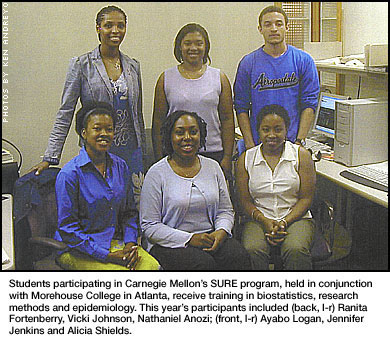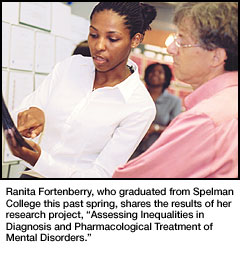|
|
||
|
|
|
 Grants Help University Train the Next Generation of Statisticians � The Department of Statistics had a pretty good summer. In fact, that may be something of an understatement. The department has received a five-year, $2 million grant from the National Science Foundation to fund its Vertical Integration of Research and Education in the Mathematical Sciences (VIGRE) program, a national initiative to increase the number of U.S. citizens who pursue and complete doctor's degrees in the mathematical sciences. Statisticians are in demand because of the increasing amount of data generated by scientific research, as well as the growing complexity of that information, said Rob Kass, head of the Statistics Department.
The overriding objective of Carnegie Mellon's VIGRE program is to train students to solve a scientific problem by translating it into a statistical question, then explaining the results so that they can be understood by the scientific community. The program also prepares graduate students and postdoctoral fellows to be university-level statistics instructors.
"Partly because of the individuals who founded and ran the department in the early days, and partly because of the cross-disciplinary emphasis of the university as a whole, we put substantial emphasis on the value of applied work and the interaction of theory and applications. This has remained one of the distinguishing characteristics of statistics at Carnegie Mellon," Kass said. The VIGRE grant wasn't the department's only good news this summer. Statistics also received a $25,000 grant from the Eli Lilly and Company Foundation to fund its Summer Undergraduate Research Internship (SURE) Program, which brings undergraduate minority students to Carnegie Mellon to learn how to conduct biostatistical research. The summer program is part of a partnership with Morehouse College in Atlanta. Students are recruited from historically black universities and colleges, and they spend the first two weeks of the program undergoing intensive training in biostatistics and epidemiology at Morehouse. At Carnegie Mellon, they spend another two weeks learning research methods and the final six weeks engaged in a research project of their choosing. This year's research projects included a study of disparities in the treatment of mental disorders between blacks and whites; an analysis of the relationship between exercise, diet, smoking and weight on people 12 years of age and older; and an examination of the rates of kidney dysfunction in blacks and whites.
For African Americans, this shortage could have grave consequences. Medical problems faced by minorities may go overlooked by researchers, or they may unknowingly practice cultural biases that skew the results of their work. "If people like us aren't doing research, and people like us aren't being heard, then people like us will continue to suffer," said Ranita Fortenberry, a program participant who graduated this spring from Spelman College in Atlanta with a degree in psychology. She is considering pursuing a graduate degree in biostatistics at the highly regarded Rollins School of Public Health at Emory University, also in Atlanta. The Summer Undergraduate Research Internship Program also happens to be the key undergraduate component of the department's VIGRE program. In addition to training students to do multidisciplinary research, the VIGRE program also emphasizes communications skills, which Kass said have been lacking among the mathematical disciplines. Students receive instruction in technical writing from the university's Department of English. Students also learn effective classroom communication skills. "The skills that you need to be an effective teaching assistant or instructor in statistics are very much the same skills that you need to be an effective communicator in applied statistical research," Kass said. Only four of 29 VIGRE proposals were awarded grants this year, said Richard Millman, VIGRE program director for the National Science Foundation. He led the NSF site visit team that reviewed Carnegie Mellon's proposal. "One of the things that is so impressive in the Carnegie Mellon proposal is the Statistics Department has a clear view of how to broaden graduate education in their department," Millman said. � � � � �
�
Top�
�
�
Jonathan Potts�
|
|
This Issue's Headlines || Carnegie Mellon News Home || Carnegie Mellon Home |
||
 Kass said that the Statistics Department's long tradition of using applied interdisciplinary research makes it well-suited to produce researchers skilled in techniques that cross academic borders. Faculty are engaged in research in astrophysics, brain imaging, genetics and finance, to name just a few areas.
Kass said that the Statistics Department's long tradition of using applied interdisciplinary research makes it well-suited to produce researchers skilled in techniques that cross academic borders. Faculty are engaged in research in astrophysics, brain imaging, genetics and finance, to name just a few areas.
 The Statistics Department launched the summer program in 2001 because of its concern about the scarcity of minorities in statistics, biostatistics and epidemiology. According to Science magazine, while African Americans, Hispanics and American Indians comprise 23% of the U.S. population, they make up only 4.5% of those holding scientific doctorates.
The Statistics Department launched the summer program in 2001 because of its concern about the scarcity of minorities in statistics, biostatistics and epidemiology. According to Science magazine, while African Americans, Hispanics and American Indians comprise 23% of the U.S. population, they make up only 4.5% of those holding scientific doctorates.